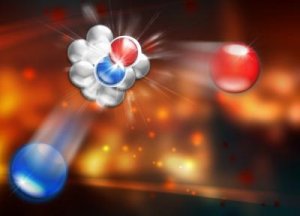
Scientists discover that protons partner with neutrons more often than with other protons
Fast-moving protons are much more likely to pair up with fast-moving neutrons than with other protons in the nuclei of atoms, according to a recent experiment performed at the U.S. Department of Energy’s Thomas Jefferson National Accelerator Facility.
The experiment confirms previous theoretical research led by Mark Strikman, a professor of physics at Penn State. Strikman’s theory predicts that fast-moving protons have a nearly 100-percent tendency to form pairs with other fast-moving protons or neutrons, and that the majority of these pairings are between protons and neutrons. Strikman also suggested the experimental strategy that the researchers at the Thomas Jefferson National Accelerator Facility used to make their discovery.
Two decades ago, Strikman and his collaborator Leonid Frankfurt of Tel Aviv University in Israel suggested that the most direct way to look for pairings of two high-momentum nucleons–a nucleon is a proton or a neutron in the nucleus of an atom–would be to knock a fast-moving nucleon out of an atom’s nucleus and to identify the nucleon that is left behind. This method was used in an experiment conducted by researchers at the Brookhaven National Laboratory, and results were published in 2003.

CREDIT: Joanna Griffin, US Department of Energy, Jefferson Lab, courtesy of Penn State
In 2006, Strikman and his colleagues published a paper in the journal Physical Review Letters in which they described the development and results of a detailed model that analyzed the Brookhaven National Laboratory data. The team’s analysis indicated that when a proton is moving faster than one-quarter the speed of light, 90 percent of the time it is paired with a neutron, while 10 percent of the time it is paired, presumably, with another proton. “Although we expected a large asymmetry between the number of proton-neutron pairs and proton-proton pairs, the magnitude of the difference was startling to us because it was a significant departure from what estimates using current models of nucleon-nucleon interactions told us it would be,” said Strikman.
Recently, a direct measurement was performed by researchers at the Thomas Jefferson National Accelerator Facility to verify the accuracy of the 90-percent to 10-percent ratio predicted by the model developed in 2006 by Strikman and his colleagues. In their experiment, the scientists sent a beam of energetic electrons into a thin sheet of carbon to knock protons out of the nuclei. Next, they counted the number of times that each proton’s remaining partner was a neutron versus another proton. Results of the experiment supported Strikman’s and Frankfurt’s predictions.
“Although we predicted a very large probability of pairing between fast-moving nucleons, it is amazing to me that 100 percent of fast-moving nucleons are paired,” said Strikman. “It also is amazing that so little of this pairing is between two protons.”
Strikman added that he is excited to finally see experimental evidence in support of the theory that he has spent much of his career establishing. “Previous methods could not distinguish between proton-proton and proton-neutron correlations,” he said. “But this new experiment has achieved something that never has been done before. The discovery is the most clear-cut example that the high-energy processes, which we have been advocating for many years, are truly effective tools and can be used for future discoveries.”
###
Research for the theoretical paper by Strikman and colleagues was funded by the Israel Science Foundation, the U.S.- Israel Binational Science Foundation, the U.S Department of Energy, and the U.S. National Science Foundation.
###
To read about the results of the experiment by the researchers at the Thomas Jefferson National Accelerator Facility
Subedi et al. Probing Cold Dense Nuclear Matter. Science, Published online May 29 2008 DOI: 10.1126/science.1156675
See also: Protons Pair Up With Neutrons: Finding Sheds New Light On Structure Of Nuclear Systems
###
Story Source:
Materials provided by Penn State.
